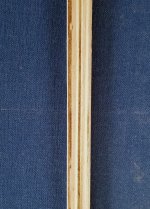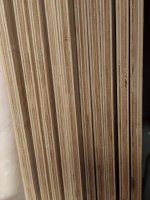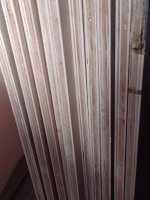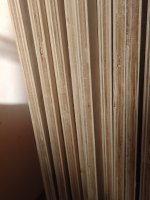Not in my build. Does not matter if you ask me.Is the aluminum sheet is touching the sides other than the one it is glued ?
Maybe we have found the same "birch" plywood as a sub for BB. My supplier said it's from Vietnam...Upon dissection the white wood is definately poplar (can see the green heart wood) but that brown stuff is a hard heavy wood almost like teak but surely not? I’m not too familiar with Vietnamese woods, but they did a pretty good job manufacturing it.

I got some in 18mm, 15mm, and 12mm.
I've made a could of large subs with the 18mm, and working on a large synergy horn made from the 12mm.
Have to stay, the stuff is a pain. 18mm bows in the rack in afew weeks faster than 9mm russian BB does in a few years.
Crap just won't stay flat, and bends too easily when clamping. Screw holding into the end grain is passable with 18mm, but a joke with 12mm, and not so good with 15mm.
I'm spending so much time 'custom' fitting everything together due to not being able to get the precision of working with BB.
Aaargh...gotta keep searching..
Yah, after working with it for a couple days i’m not real impressed either……lowes has a 3/4“ marine grade a/b fir, but its $150 a sheet, i‘ve used it before and is great to work with, the Vietnamese stuff is under $50 a sheet for 3/4” so definitely good enough for prototyping!
I have used some "birch" plywood from Home Depot recently, it was labeled "made in Indonesia". The interior plies were a soft, low density white wood, that seemed very similar to poplar... but I am not sure it was. I was allergic to the dust, and I have never been (nor am I now) allergic to the poplar core of Canadian or US plywood. And it makes sense that in a country of tropical forests, the local lumber industry would find an appropriate local tree, something white and low density like poplar. How dumb would it be to ship poplar from north America into southeast Asia to make plywood which was then shipped to north America. Very dumb... especially since the making of plywood is not labor intensive. It is mostly done by automation.
@hifijim
It's as dumb as the rest of the world economy.
For example, depending on the time of the year, we get gala apples from either Germany, Austria, France, the Netherlands, Chili or New Zealand. Apparently the last two countries are cheaper to ship from in certain months? (I have to say that the NZ ones taste best BY FAR!!)
Also, apparently here people eat a lot less chicken drumsticks, while liking more chicken filet. While certain countries in Asia rather eat the drumsticks instead of the filet.
So the drumsticks are being shipped all the way across the globe to basically get filet in return. Which is also being shipped across the globe.
Crazy to think of.
Apparently enough to make a better profit.
It's as dumb as the rest of the world economy.
For example, depending on the time of the year, we get gala apples from either Germany, Austria, France, the Netherlands, Chili or New Zealand. Apparently the last two countries are cheaper to ship from in certain months? (I have to say that the NZ ones taste best BY FAR!!)
Also, apparently here people eat a lot less chicken drumsticks, while liking more chicken filet. While certain countries in Asia rather eat the drumsticks instead of the filet.
So the drumsticks are being shipped all the way across the globe to basically get filet in return. Which is also being shipped across the globe.
Crazy to think of.
Apparently enough to make a better profit.
Yes, like the Ford Transit and the Chicken Tax.
https://en.wikipedia.org/wiki/Chicken_tax said:As an unintended consequence, several importers of light trucks have circumvented the tariff via loopholes, known as tariff engineering. For example, Ford, which was one of the main beneficiaries of the tax, also evaded it by manufacturing first-generation Transit Connect light trucks for the US market in Turkey; these Transits were fitted-out as passenger vehicles, which allowed Ford to evade the Chicken tax when the vehicles passed customs in the US. The Transits were stripped pre-sale of their rear seats and seatbelts, at a Ford warehouse near Baltimore.[1] In 2020, after an exhaustive battle between Customs and Border Protection (CBP) and Ford, Ford's appeal to the Supreme Court of the United States to hear arguments stemming from a June 7, 2019[8] reversal of a Court of International Trade decision was denied, and Ford was ordered to pay the deficient duties and almost $1.3 billion USD in penalties.[9] Similarly, to import cargo vans built in Germany, Mercedes disassembled fully-completed vehicles and shipped the components to "a small kit assembly building" in South Carolina, where they were reassembled.[10] The resulting vehicles emerged as locally manufactured, free from the tariff. Possible CBP litigation is pending.
Just started looking into sourcing decent ply in the UK.
Wow! £250 for 1 sheet of Birch ply. (plydirect)
Is MDF really that bad, at 1/6th the price?
Wow! £250 for 1 sheet of Birch ply. (plydirect)
Is MDF really that bad, at 1/6th the price?
I've just bought a few sheets (18mm and 25mm) of this for a home project. Not cut any yet but if it's good I'll use it for my next speaker build.
https://www.coversmerchants.co.uk/h...m-fsc-certified-hardwoodthroughoutcertified-c
https://www.coversmerchants.co.uk/h...m-fsc-certified-hardwoodthroughoutcertified-c
thanks thats a good source if it ends up being decent delivery is reasonable as well . I've bought quite a few 18mm sheets from wickes for some furniture making at home . it's not the best but a lot better than the usual crap you get in b&q etc where the veneer falls off everywhere when you cut it . there's half a sheet outside been lying in the rain as a workbench for months and it still hasn't delaminated so the glues theg used must be pretty goodI've just bought a few sheets (18mm and 25mm) of this for a home project. Not cut any yet but if it's good I'll use it for my next speaker build.
I'd be amazed if its free of voids at that price. My local supply has Birch ply for £156, Marine for £82, WBP for £44 and shuttering for £26. There's also phenolic for megabucks....I've just bought a few sheets (18mm and 25mm) of this for a home project. Not cut any yet but if it's good I'll use it for my next speaker build.
https://www.coversmerchants.co.uk/h...m-fsc-certified-hardwoodthroughoutcertified-c
From a performance standpoint, MDF is not a bad material. It is a pretty good material. Compared to Baltic birch plywood, it a lower stiffness to weight ratio because it is fairly dense and not very stiff. This means that bracing will need to be a little closer together than in a plywood cabinet, but that is OK if we know that going in. On the other hand, it seems to have a bit higher internal damping compared to Baltic birch plywood.Is MDF really that bad, at 1/6th the price?
MDF is hard to work with because the excessive dust. There is a lot of fine dust when cutting or machining, and this means the shop must have a first rate dust collection system. When I cut timber and plywood, I wear an N95 mask for some operations like a router or surface planer, but most of the time I don't need one. When I work with MDF, I need an N95 mask for almost any operation.
In a home shop, or a small business shop, this extra dust collection requirement can be a challenge. In a large commercial shop, they will already have a high performance dust collection system, and they may have work rules that require facial/respiratory protection for ALL operations anyway. In that environment, the difference between working with plywood and MDF may be minimal.
MDF is a great material if you are going to apply a painted finish. As you pointed out, MDF has a very large cost advantage. If it is truly 1/6 the price, that is a pretty compelling reason to choose MDF... and learn to live with the disadvantages.
Hi Jim, Yes MDF is nasty stuff to work with, carcinogenic nasty. Weather pemitting I'll have the shop doors wide open and the extraction on and probably a mask for good measure. I can get the boards pre cut at the supplier too, so just the circles to router out and maybe a champher or round over on the edges.From a performance standpoint, MDF is not a bad material. It is a pretty good material. Compared to Baltic birch plywood, it a lower stiffness to weight ratio because it is fairly dense and not very stiff. This means that bracing will need to be a little closer together than in a plywood cabinet, but that is OK if we know that going in. On the other hand, it seems to have a bit higher internal damping compared to Baltic birch plywood.
MDF is hard to work with because the excessive dust. There is a lot of fine dust when cutting or machining, and this means the shop must have a first rate dust collection system. When I cut timber and plywood, I wear an N95 mask for some operations like a router or surface planer, but most of the time I don't need one. When I work with MDF, I need an N95 mask for almost any operation.
In a home shop, or a small business shop, this extra dust collection requirement can be a challenge. In a large commercial shop, they will already have a high performance dust collection system, and they may have work rules that require facial/respiratory protection for ALL operations anyway. In that environment, the difference between working with plywood and MDF may be minimal.
MDF is a great material if you are going to apply a painted finish. As you pointed out, MDF has a very large cost advantage. If it is truly 1/6 the price, that is a pretty compelling reason to choose MDF... and learn to live with the disadvantages.
I really like the idea of a painted finish too. I may go crazy and do an acrylic pour with resin over the top... or maybe a wrap...
As I'm doing a TL, there's a load of bracing inside anyway.
Cost wise, well I can get 'ply' for the same price as MDF but it will be rubbish and very frustrating to try and use. I did find Birch ply at my local wood yard for a mere £156, so only 4.5 times the price of MDF.
I’ve been using MDO for years now. It’s heavily saturated with phenolic material and extremely stable. I veneer my own stuff so the paper face is an amazing substrate. Holds fasteners better than any laminate I’ve ever worked with likely due to the high glue content. And those that like to paint speakers instead of stain?…….super easy and will hold paint forever.
What is MDO?
I'm using MR (moisture resistant, the green stuff) MDF for the body of speakers and switched to painting it. I use Birch Ply for the baffle, because it looks nice on the edge and adds a contrast in materials / finish.
I upgraded my shop extraction, lol. When I finally get around to it, I plan to move my extraction system outside the main workshop in it's own little house. That way the dust is really being pulled out of my workshop rather than getting recycled through the filters.
Painting nicely does take a lot of work though, and sanding the primer is another dusty job in itself.
I'm using MR (moisture resistant, the green stuff) MDF for the body of speakers and switched to painting it. I use Birch Ply for the baffle, because it looks nice on the edge and adds a contrast in materials / finish.
I upgraded my shop extraction, lol. When I finally get around to it, I plan to move my extraction system outside the main workshop in it's own little house. That way the dust is really being pulled out of my workshop rather than getting recycled through the filters.
Painting nicely does take a lot of work though, and sanding the primer is another dusty job in itself.
I have never used it, so I can't comment on it. It seems like an attempt to get the smooth paint-friendly feature of MDF combined with the advantages of plywood. It seems like a good compromise for those paint applications where finishing the material edge is not required.
I just made a countertop using 1" HDF, thinking I could also get a sense of if I can use the stuff for speakers.
Overcame the fact a 4' x 8' sheet weighs a stinking 130 lbs. (alot for a dude in his early 70's to get out of the pickup and into the garage by himself)
But dang...I get why the stuff is so heavy....it's nothing but glue...about 80% the density of water.
No such thing as saw dust Lol....just dang glue dust.
May no speaker I ever contemplate be either MDF or HDF. 👎
Overcame the fact a 4' x 8' sheet weighs a stinking 130 lbs. (alot for a dude in his early 70's to get out of the pickup and into the garage by himself)
But dang...I get why the stuff is so heavy....it's nothing but glue...about 80% the density of water.
No such thing as saw dust Lol....just dang glue dust.
May no speaker I ever contemplate be either MDF or HDF. 👎
Did you cut into this yet? Looking around at my options, and Covers have a branch just down the road from meI've just bought a few sheets (18mm and 25mm) of this for a home project. Not cut any yet but if it's good I'll use it for my next speaker build.
https://www.coversmerchants.co.uk/h...m-fsc-certified-hardwoodthroughoutcertified-c
- Home
- Loudspeakers
- Multi-Way
- Birch Plywood Alternative


